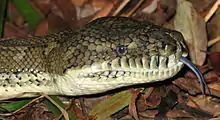زبان چنگالی
زبان چنگالی زبانی که سر آن دو شاخ شدهاست، این نوع زبان ویژگی مشترک بیشتر گونههای خزندگان است. خزندگان با کمک نوکهای زبانشان میتوانند بو بکشند و البته جهت بو را هم تشخیص دهند. داشتن حس در دو سوی سر و پیگیری رد محرکها بر پایهٔ مواد شیمیایی، بازکنش نام دارد.[1] البته هنوز قطعی نیست که زبان چنگالی خزندگان به آنها در ردیابی کمک میکند یا این تنها یک فرضیه است.[2][3][4]

زبان چنگالی در پولکداران (مارمولکها و مارها) به دلایل گوناگون توسعه پیدا کردهاست. یکی از مزایای داشتن زبان چنگالی داشتن سطح تماس بیشتر با هوا و امکان بازکنش بهتر است.[5] زبان بهطور منظم از دهان بیرون میآید تا مواد شیمیایی پیرامون را بررسی کند. این نوع بو کشیدن به جانور امکان میدهد تا موادی که بخارهای شیمیایی در هوا تولید نمیکنند را هم حس کنند کاری که با دستگاه بویایی معمول امکانپذیر نیست.[6][7][8] این توانایی پیشرفته در حس مواد شیمیایی در پیرامون، مزایای فراوانی دارد از جمله: شناسایی شکار، انتخاب جفت، شناسایی پناهگاه، جستجوی ردپا، تشخیص خویشاوندان و ...[8]
زبان چنگالی چندین بار در پولکداران دچار تغییر و تکامل شدهاند اما بر پایهٔ اطلاعات ژنتیکی هنوز معلوم نیست که دقیقاً کی این اتفاق افتاده است.[1][9]
مگسمرغ هم زبانی دو شاخ دارد.[10] شبدوست هم یک زبان دوم دارد که زیر زبان اولش پنهان است و از آن برای جارو کردن پیرامون استفاده میکند.[11]
در ادبیات
در ادبیات انگلیسی استفاده از عبارت زبان چنگالی غیر از معنی ظاهری آن میتواند به معنی رو راست نبودن هم باشد. برای نمونه این عبارت در کتاب بهشت گمشده آورده شدهاست.[12]
جستارهای وابسته
- Doublespeak
- Tongue splitting (a surgical procedure)
- Silver tongue (disambiguation)
- Ankyloglossia
- Dicroglossidae
منابع
- Schwenk, K. 1994. Why snakes have forked tongues. Science 263:1573-1577.
- Kubie, J. L. , and M. Halpern. 1979. Chemical senses involved in garter snake prey trailing. Journal of Comparative and Physiological Psychology 93:648-667.
- Waters, R. M. 1993, Odorizedair current trailing by garter snakes, Thamnophis sirtalis. Brain Behavior Evolution 41:219-223.
- Parker, M. R. , B. A. Young, and K. V. Kardong. 2008. The forked tongue and edge detection in snakes (Crotalus oreganus): an experimental test. Journal of Comparative Psychology 122:35-40.
- Cooper, W. E. 1995a. Evolution and function of lingual shape in lizards, with emphasis on elongation, extensibility, and chemical sampling. Journal of Chemical Ecology 21:477-505.
- Baxi, K. N. , K. M. Dorries, and H. L. Eisthen. 2006. Is the vomeronasal organ system really specialized for detecting pheromones? Trends in Neurosciences 29:1-7.
- Shine, R. , X. Bonnet, M. J. Elphick, and E. G. Barrott. 2004. A novel foraging mode in snakes: browsing by the sea snake Emydocephalus annulatus (Serpentes, Hydrophiidae). Functional Ecology 18:16-24.
- Schwenk, K. 1995. Of tongues and noses, chemoreception in lizards and snakes. Trends in Ecology & Evolution 10:7-12.
- Townsend, T. M. , A. Larson, E. Louis, and J. R. Macey. 2004. Molecular phylogenetics of Squamata: the position of snakes, Amphisbaenians, and Dibamids, and the root of the Squamate tree. Systematic Biology 53:735-757.
- Bill Hilton Jr (2007-06-12). "Hummingbird Internal Anatomy and Physiology". Operation RubyThroat: The Hummingbird Project. Hilton Pond Center for Piedmont Natural History. Retrieved 2008-02-13.
The tongue itself splits in the floor of the mouth
- Monkeyland. "Bushbaby - Galago moholi". Meet Our Primates. Monkeyland Primate Sanctuary. Archived from the original on 22 October 2007. Retrieved 2008-02-13.
equipped with a second, pointy tongue underneath their normal one
- https://books.google.com/books?id=68BYAAAAcAAJ&pg=PA393&dq="forked+tongue"&hl=en&sa=X&ei=wTpTVNaXI5HViALjoIGwCA&ved=0CDQQ6AEwBA#v=onepage&q="forked%20tongue"&f=false